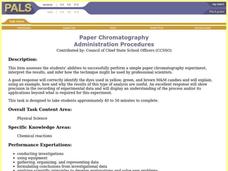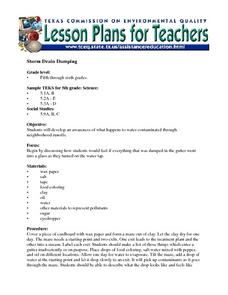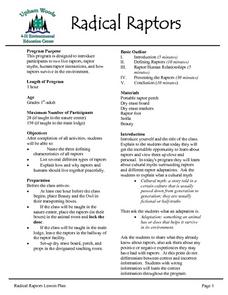Curated OER
Earth's Atmosphere and Temperature
Students explore the layers of earth's atmosphere and conduct an experiment to identify carbon dioxide. They construct models using styrofoam to represent molecules in the atmosphere's layers. To discover how sunlight efffects...
Curated OER
Paper Chromatography
Small groups of students perform paper chromatography to separate food dyes into their component colors. Students perform the experiment and collect, organize, and represent their data to form an explanation of their outcomes. Students...
Curated OER
Recyclers Revisited
Fifth graders observe their plant experiments that they started in a previous lesson and examine the role of decomposers in the nitrogen cycle. Two weeks after they set up a worm terrarium, they analyze any changes they observe, and...
Curated OER
Energy/Light/Heat/Sound
Fourth graders study the properties of heat in this series of lessons. They discuss sources of heat and experiment to determine its properties. They identify insulators and conductors by measuring temperatures, and graphing their data....
Curated OER
What's the Difference Between Concentration and Solubility?
High schoolers discuss the difference between concentration and solubility as well as examine the difference in a hands-on activity. Using water and table salt, they experiment with solubility. They create different concentrations using...
Curated OER
Testing for Catalase Activity
In this catalase worksheet, students read about how enzymes work in cells. Then students conduct an experiment to test for catalase activity in potatoes. This worksheet has 1 graph and 6 short answer questions.
Curated OER
Vegetable Faces: A Guiseppe Archimboldo Portrait Study
Students create drawings of vegetable faces.In this early childhood lesson plan, students identify various vegetables, which they use as models to create drawings. Students experiment with the vegetable drawings by adding faces to their...
Curated OER
Check Out Lights and Shields with Beads
Students explore Ultraviolet detecting beads and conduct several investigations with them. In this investigative lesson plan students participate in an experiment to see the harmful effects of UV light and discuss their findings.
Curated OER
A Day at the Beach-Why Did We Do It?
Learners investigate pollution at the beach. In this environmental lesson plan, students participate in a beach clean-up and calculate the weight of the debris collected. Learners write a reflection in their journal about their beach...
Curated OER
Composting Leftovers
In this composting leftovers instructional activity, students set up an experiment with food waste and soil, observing and recording the differences for two weeks.
Curated OER
Products from Petroleum
Students examine products that are petroleum based. In this petroleum product lesson, students examine a display of petroleum based products. They discuss the products that are made from crude oil and conduct an experiment that...
Curated OER
Chemical Changes
Second graders investigate chemical changes and reactions and will identify four characteristics that indicate a chemical change. In this chemical change lesson plan, 2nd graders perform experiments that promote chemical changes. They...
Curated OER
Mimicry: Other Insects That Resemble Bees
Students design a conceptual experiment to test whether mimics actually benefit from the fact they resemble other organisms or objects. They define the term mimicry. They focus on insects that resemble bees and wasps.
Curated OER
Storm Drain Dumping
Students conduct an experiment to show how water gets contaminated through neighborhood runoffs.
Curated OER
Texas Estuary Project
Students take a field trip to a local estuary and analyze water samples. They analyze and graph the data results, write an essay, and create a food web of their field site.
Curated OER
The Conceptual Theory of Chromatography
Students conduct a lab to determine the best way to separate a variety of mixtures choosing between paper, thin layer and column chromatography. They use chromatography techniques to identify unknown substances and submit a lab report on...
Curated OER
Agriculture is a Cycle
What do a bicycle and the life cycle have in common? Cover this and more with the series of cross-curricular activities included in this plan. Learners do everything from making bracelets that represent the life cycle to checking out the...
Curated OER
A Priceless Collection
Students read about and discuss life of Russian geneticist Nikolai Vavilov, define terms related to field of genetics, complete worksheets, conduct seed experiments, observe and record results, and locate seed banks on world map or globe.
Curated OER
Genetic Engineering
Pupils are introduced to the concept of genetic engineering. In groups, they participate in a variety of experiments, in which they analyze the effect of chemicals on different substances. Using the internet, they research gossypol, test...
Curated OER
Edible Rock Layers
Pupils use edible food items to conduct an experiment that simulates the movement, folding, and faulting of rock strata like sandstone, siltstone, limestone, and shale. Students then get to eat the experiment when completed.
Curated OER
Magnets, Electromagnets, and Motors
Learners investigate the concepts of magnetism and its properties. They construct a magnet and test foods for iron content. Then students define the use of a motor and make their own electric motor while working in small groups. Then...
Curated OER
The Floating Golf Ball
Students explore density by floating golf balls. They explore having their golf balls float halfway in a container of water and discuss density and its realtionship to where the golf balls are floating. After adding food coloring, they...
Curated OER
Radical Raptors
Students are introduced to raptors and their role in the environment. They identify three characteristics of raptors and list several types of raptors found in nature. They discuss their positive and negative experiences with raptors and...
Curated OER
Starch is Everywhere
In this science activity, students add a few drops of iodine solution to each of 10 substances to determine if they contain starch. The iodine will turn blue if the item contains starch.

























